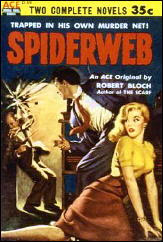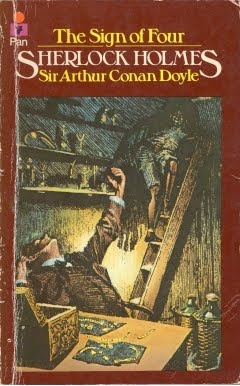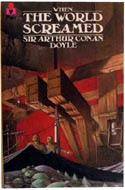 At the Earth's Core, published in 1922, was the first of Edgar Rice Burroughs’ Pellucidar novels. I’ve always found his books to be highly entertaining and ingenious in their imagining of strange worlds and that’s certainly the case with this one.
At the Earth's Core, published in 1922, was the first of Edgar Rice Burroughs’ Pellucidar novels. I’ve always found his books to be highly entertaining and ingenious in their imagining of strange worlds and that’s certainly the case with this one.The book opens with a framing story, as the narrator encounters a solitary and rather disheveled European somewhere in the wastes of the Sahara Desert. The man is named David Innes and he has a strange story to tell.
Professor Perry has invented a machine called the Prospector, although he sometimes refers to it as the Iron Mole. It’s an enormous manned digging machine a hundred feet long designed to burrow deep below the surface of the Earth. David had been an ex-student of his and was a wealthy young man and he’d agreed to finance the professor’s project.
When they take the Prospector for a test run things go horribly wrong. The machine gets out of control and takes them much much deeper into the Earth’s crust than they anticipated. As the temperatures rises alarmingly and their air supply nears exhaustion they prepare themselves for death but then the temperature plummets, rises again, and then plummets again. The machine then breaks through the Earth’s crust. They assume that they emerged somewhere on the surface, but in fact they are now in the strange inside-out world of Pellucidar.
The Earth is hollow, and the world of Pellucidar occupies the inside surface of the planetary crust. Obviously there are major problems making such a world sound even vaguely plausible. Where would they get their sunlight from? Or indeed any light at all? How would gravity work in such a world? Burroughs comes up with some pretty nifty ideas for solving these problems. They’re all ridiculous of course, but they’re clever and once you accept the idea of an inside-out world they do have a certain crazy logic, and even certain elegance.
There are people in Pellucidar, but they’re not the dominant race. The rulers of Pellucidar are the Mahars. They’re winged dinosaurs, rhamphorynchus in fact, although much bigger than the actual rhamphorynchus that once inhabited our outer world. They have no ears but are able to communicate with each other by some means that never becomes entirely clear to our intrepid inner-world explorers. They are intelligent and literate. They are served by the subject race of the Sagoths, a kind of apemen, less intelligent but useful as the Mahars’ foot-soldiers. Menial work is done by human slaves.
Professor Perry and David are soon captured by the Sagoths, to be pressed into service as slave labourers. Among the other captives of the Sagoths David meets Dian the Beautiful. She is a princess of one of the human tribes, proud and beautiful. David’s attempts to befriend her come to grief when he accidentally offends her, princesses being fairly easy to offend.
David eventually escapes but he will have to return to the Mahar city to rescue Professor Perry. He is also determined to find Dian again, and he is starting to form plans to liberate Pellucidar from the Mahars. There will be many hazards, Pellucidar being full of gigantic and extremely fierce animals, many of them long extinct on the upper world, and many much larger in size than the animals of our world. Combined it the menace of the Mahars and the Sagoths he is setting himself quite a task.
It’s all outrageously entertaining and Pellucidar is a strange and fascinating world brought vividly to life (as is the case with Burroughs’ other imaginary worlds). It has beautiful princesses, savage monsters and a brave and noble hero. These are features that might be sneered at today but there’s a lot to be said for them. They work for me anyway.
Burroughs died in 1950. His work remained popular for many years and experienced a revival in the 70s when the sword & sorcery genre was at the peak of its popularity. Sadly he’s been rather forgotten since then but the good news is that so many of his books are now once again available, mostly in print-on-demand form.
He’s an under-appreciated writer whose influence on the science fiction and fantasy genres is seriously underrated.
Definitely recommended.





